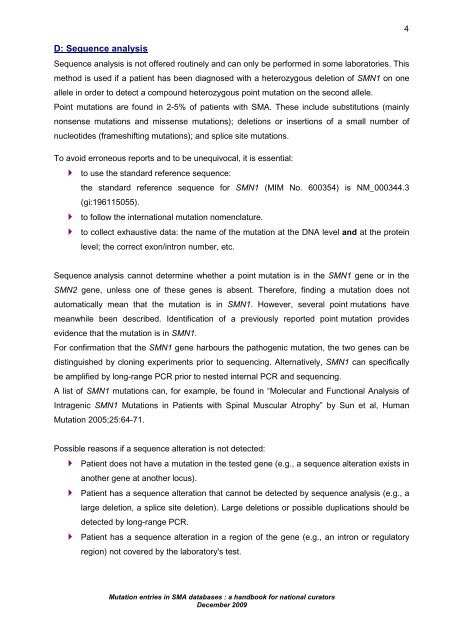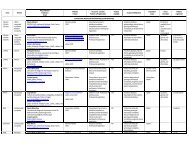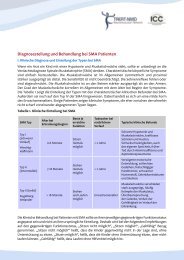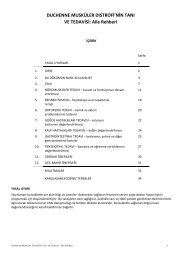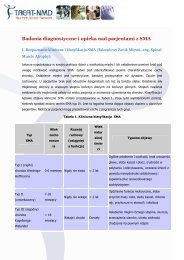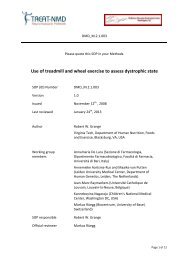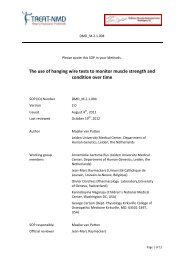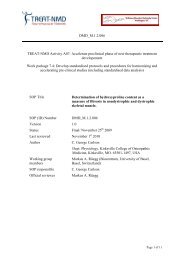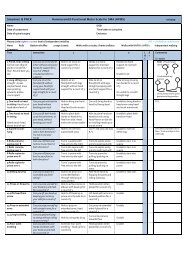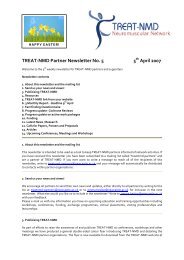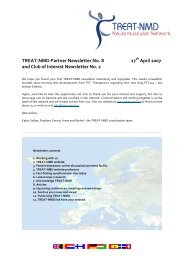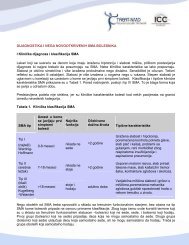A handbook on SMA genetics - Treat-NMD
A handbook on SMA genetics - Treat-NMD
A handbook on SMA genetics - Treat-NMD
Create successful ePaper yourself
Turn your PDF publications into a flip-book with our unique Google optimized e-Paper software.
4<br />
D: Sequence analysis<br />
Sequence analysis is not offered routinely and can <strong>on</strong>ly be performed in some laboratories. This<br />
method is used if a patient has been diagnosed with a heterozygous deleti<strong>on</strong> of SMN1 <strong>on</strong> <strong>on</strong>e<br />
allele in order to detect a compound heterozygous point mutati<strong>on</strong> <strong>on</strong> the sec<strong>on</strong>d allele.<br />
Point mutati<strong>on</strong>s are found in 2-5% of patients with <strong>SMA</strong>. These include substituti<strong>on</strong>s (mainly<br />
n<strong>on</strong>sense mutati<strong>on</strong>s and missense mutati<strong>on</strong>s); deleti<strong>on</strong>s or inserti<strong>on</strong>s of a small number of<br />
nucleotides (frameshifting mutati<strong>on</strong>s); and splice site mutati<strong>on</strong>s.<br />
To avoid err<strong>on</strong>eous reports and to be unequivocal, it is essential:<br />
to use the standard reference sequence:<br />
the standard reference sequence for SMN1 (MIM No. 600354) is NM_000344.3<br />
(gi:196115055).<br />
to follow the internati<strong>on</strong>al mutati<strong>on</strong> nomenclature.<br />
to collect exhaustive data: the name of the mutati<strong>on</strong> at the DNA level and at the protein<br />
level; the correct ex<strong>on</strong>/intr<strong>on</strong> number, etc.<br />
Sequence analysis cannot determine whether a point mutati<strong>on</strong> is in the SMN1 gene or in the<br />
SMN2 gene, unless <strong>on</strong>e of these genes is absent. Therefore, finding a mutati<strong>on</strong> does not<br />
automatically mean that the mutati<strong>on</strong> is in SMN1. However, several point mutati<strong>on</strong>s have<br />
meanwhile been described. Identificati<strong>on</strong> of a previously reported point mutati<strong>on</strong> provides<br />
evidence that the mutati<strong>on</strong> is in SMN1.<br />
For c<strong>on</strong>firmati<strong>on</strong> that the SMN1 gene harbours the pathogenic mutati<strong>on</strong>, the two genes can be<br />
distinguished by cl<strong>on</strong>ing experiments prior to sequencing. Alternatively, SMN1 can specifically<br />
be amplified by l<strong>on</strong>g-range PCR prior to nested internal PCR and sequencing.<br />
A list of SMN1 mutati<strong>on</strong>s can, for example, be found in “Molecular and Functi<strong>on</strong>al Analysis of<br />
Intragenic SMN1 Mutati<strong>on</strong>s in Patients with Spinal Muscular Atrophy” by Sun et al, Human<br />
Mutati<strong>on</strong> 2005;25:64-71.<br />
Possible reas<strong>on</strong>s if a sequence alterati<strong>on</strong> is not detected:<br />
Patient does not have a mutati<strong>on</strong> in the tested gene (e.g., a sequence alterati<strong>on</strong> exists in<br />
another gene at another locus).<br />
Patient has a sequence alterati<strong>on</strong> that cannot be detected by sequence analysis (e.g., a<br />
large deleti<strong>on</strong>, a splice site deleti<strong>on</strong>). Large deleti<strong>on</strong>s or possible duplicati<strong>on</strong>s should be<br />
detected by l<strong>on</strong>g-range PCR.<br />
Patient has a sequence alterati<strong>on</strong> in a regi<strong>on</strong> of the gene (e.g., an intr<strong>on</strong> or regulatory<br />
regi<strong>on</strong>) not covered by the laboratory's test.<br />
Mutati<strong>on</strong> entries in <strong>SMA</strong> databases : a <str<strong>on</strong>g>handbook</str<strong>on</strong>g> for nati<strong>on</strong>al curators<br />
December 2009


